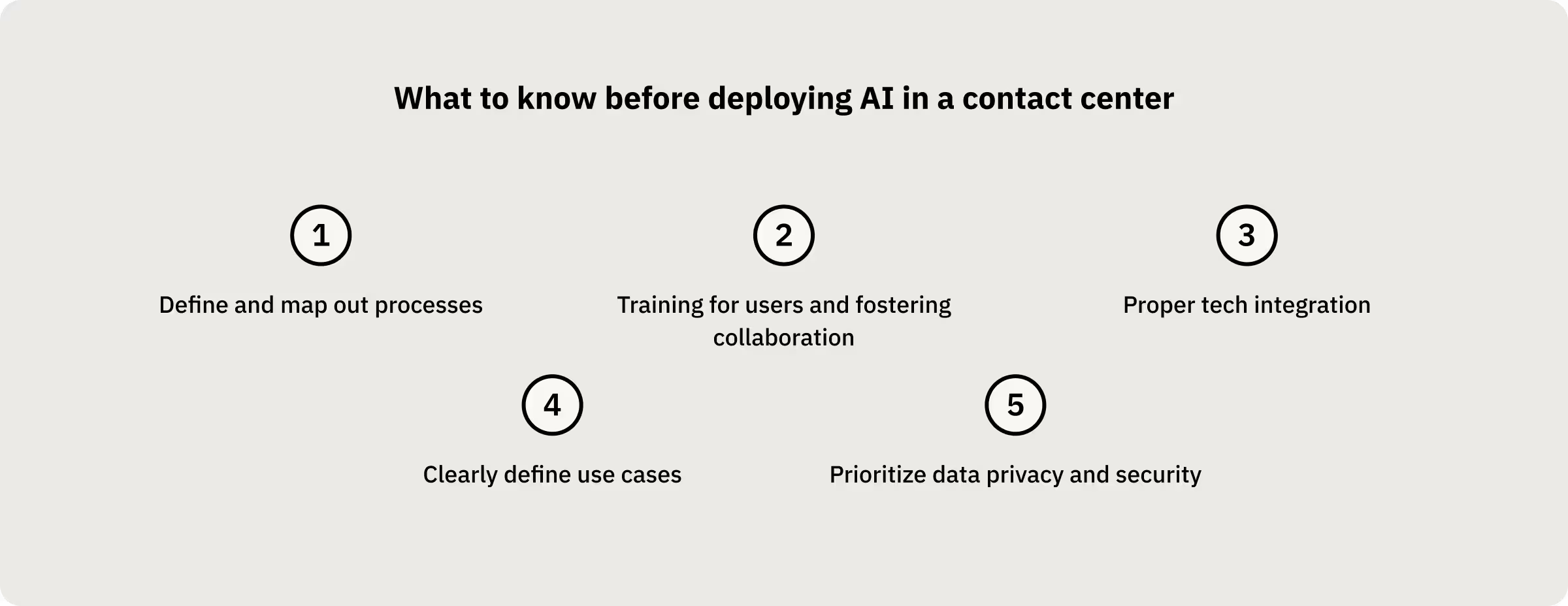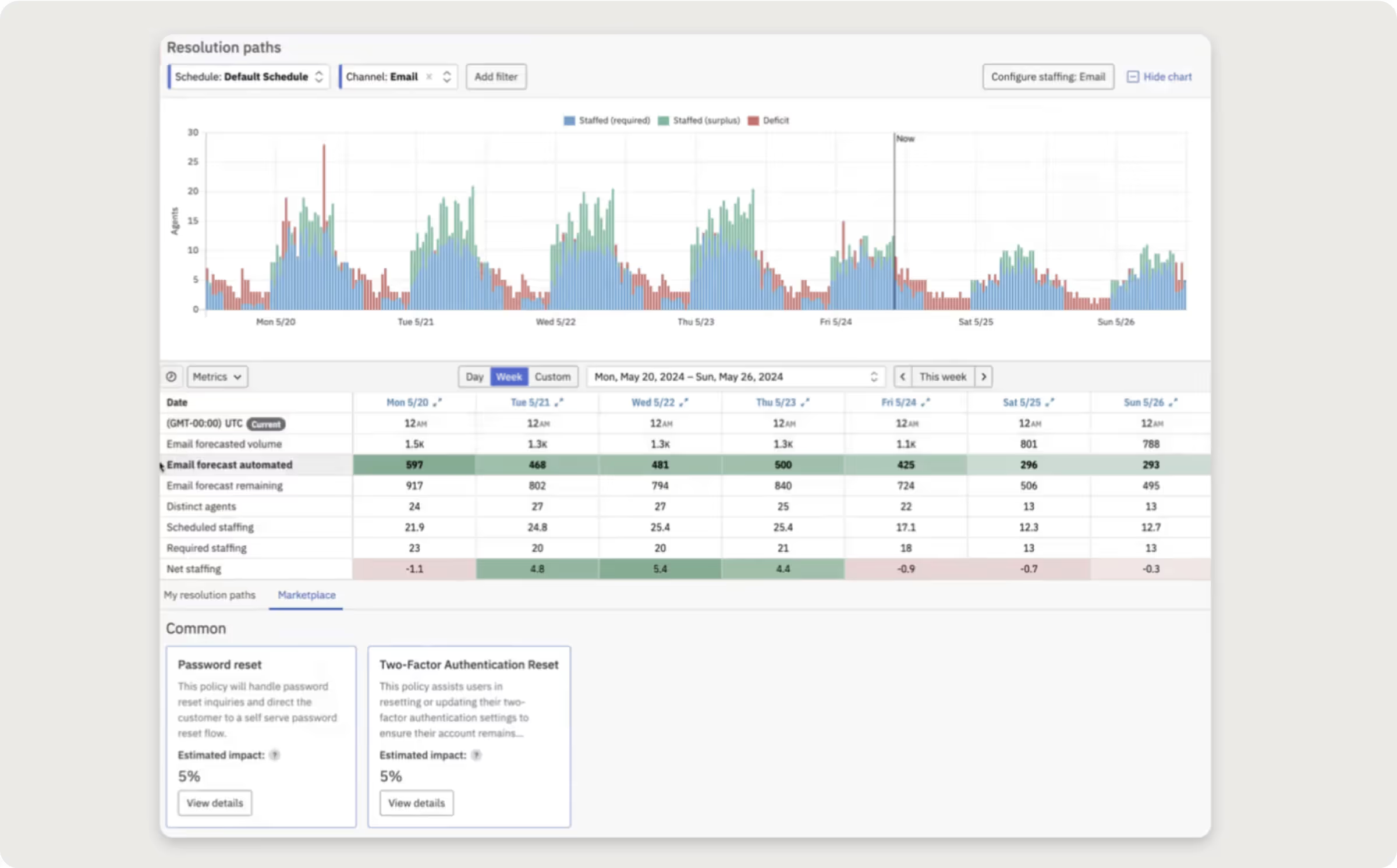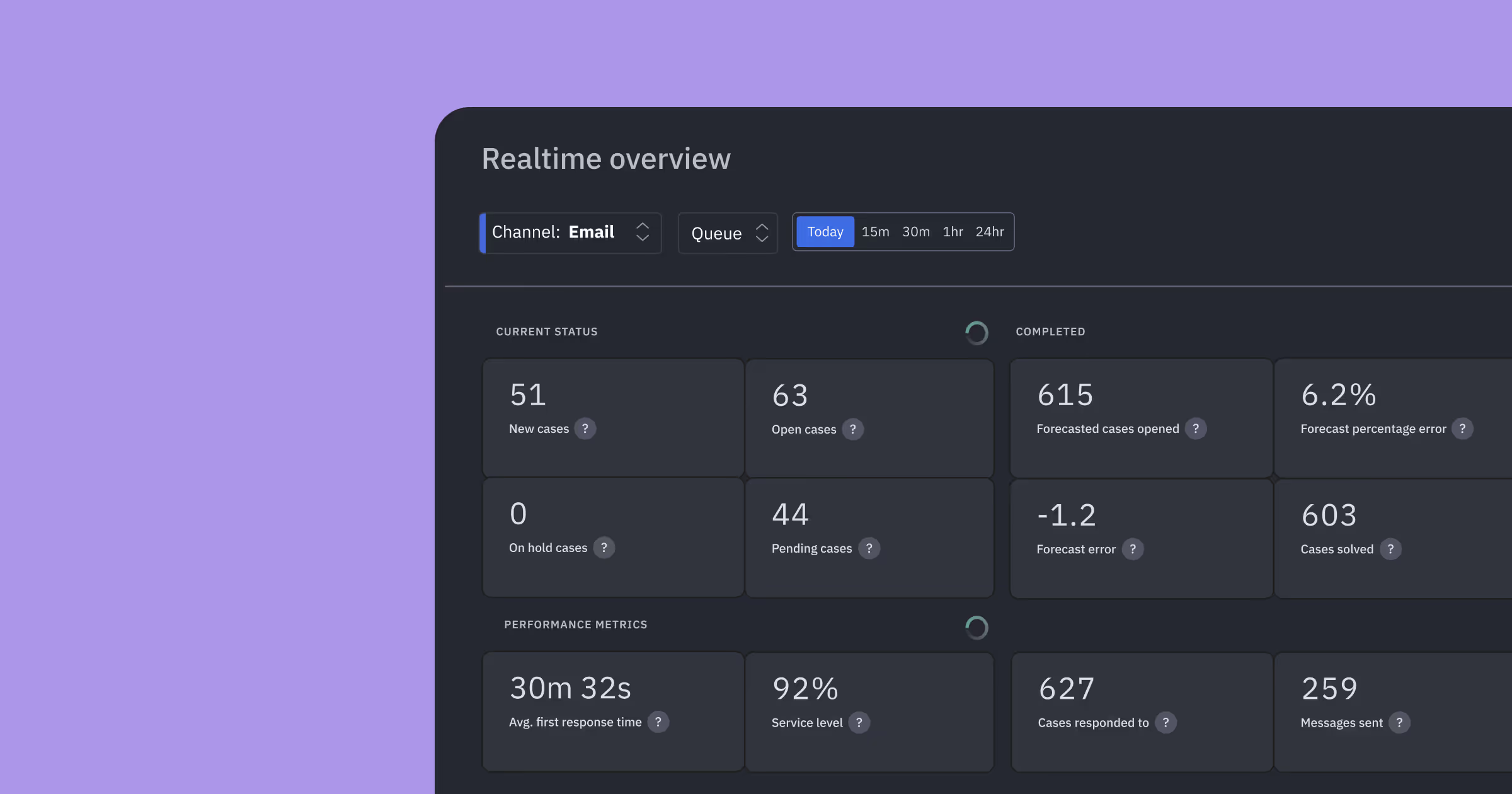AI contact center: Enhancing omnichannel customer experience
See demo
AI contact center: enhancing omnichannel customer experience
AI contact center: what is it?
AI contact centers harness cutting-edge technologies to revolutionize communication, streamline operations, and deliver personalized customer service across all communication channels. By integrating AI, these centers tackle tasks much more efficiently compared to purely manual processes. Time-consuming and error-prone processes like routing calls, answering queries, and analyzing customer data happen in the blink of an eye in AI contact centers.
Today, no contact center can afford not to think about the transformation to an AI contact center. Read on to learn how to decode the AI landscape and where to start making the right investments in AI that will help your contact center gain unmatched efficiency while ensuring an amazing experience for customers.
How AI helps contact centers overcome operational challenges
Historically, contact centers leaned heavily on manual processes, which meant grappling with inefficiencies, long wait times, and inconsistent customer experiences. Speeding up the process meant either adding more staff or trading off quality — either of which comes at a cost.
Contact centers without AI encounter a number of operational limitations, including:
- Manual workflows: In traditional contact centers, human agents handle all interactions. Since humans are limited by their bandwidth, bottlenecks are inevitable. Those backups in cases lead to human errors as agents struggle to keep up and, eventually, those agents will burn out.
- Basic case routing: Without AI, cases are routed based on simple, rigid rules that don’t consider the nuances of customer needs or agent expertise. When a case doesn’t easily fit into a pre-defined rule, it will get transferred and escalated, resulting in confusion, frustration and — that’s right — even more manual work to get things fixed.
- Limited data utilization: We’re swimming in a sea of data about our customers, but all too often that data is fragmented and underutilized. This makes it difficult to provide the personalized and cohesive service experiences that today’s customers have come to expect.
With the integration of AI, contact centers are equipped to overcome these challenges and operate more efficiently by:
- Automating interactions: AI can handle routine inquiries through self-service solutions such as chatbots and virtual agents, reducing the workload on contact center agents and ensuring customers receive immediate responses.
- Routing cases intelligently: AI analyzes customer queries in real-time and routes them to the most appropriate agent or resource, significantly reducing wait times and improving first-contact resolution rates.
- Breaking down data silos: AI consolidates data from various channels to create unified customer profiles, enabling personalized and consistent interactions across all touchpoints. These insights can be translated into actionable insights that up-level the customer experience.
Modernizing the contact center with AI
Modernizing contact centers with AI is essential for delivering the best possible customer support across a growing number of channels. AI contact center transformation ensures customers receive seamless, efficient service across any communication channel they choose — whether it's phone, email, chat, or social media. With AI, contact center managers don’t have to choose between improving operational efficiency and elevating the customer experience. With the right implementation of AI, these contact centers will drive higher satisfaction, loyalty, and engagement because people are getting the help they need, faster and more accurately — no trade-off required!
AI contact centers use a range of advanced technologies to improve functionality and efficiency, with different technologies being more fit for use in different areas. Let’s take a minute to define the key components driving this innovation:
- Large language models (LLMs):
- Function: Trained on enormous data sets, LLMs power interactions that feel like real human dialogue. LLMs power the new wave of generative AI (genAI) software offerings.
- Application: Deliver next-generation support automation, from helping agents get answers and draft replies to intelligent, end-to-end resolution of customer issues.
- Natural language processing (NLP):
- Function: Enables AI to understand, interpret, and respond to human language.
- Application: Used in conversational AI chatbots and virtual agents for basic interactions with customers and deflection to self-service resources.
- Machine learning (ML):
- Function: Allows AI systems to learn from data and improve their performance over time.
- Application: Help in predicting customer needs, optimizing routing algorithms, and enhancing decision-making processes.
- AI chatbots and virtual agents:
- Function: Automates responses to common customer inquiries, providing instant support.
- Application: Available 24×7 to handle routine questions, guide customers through processes, and escalate issues to contact center agents when necessary.
- Predictive analytics:
- Function: Uses historical data to forecast future trends and behaviors.
- Application: Helps anticipate customer needs, plan staffing requirements, and improve proactive customer service.
- Speech recognition:
- Function: Converts spoken language into text.
- Application: Used in voice-based interactions to understand and process customer requests, enabling efficient handling of customer calls.
- Sentiment analysis:
- Function: Analyzes customer emotions and attitudes through text and voice data.
- Application: Helps in identifying dissatisfied customers and prioritizing their issues for quicker resolution.
- Unified customer profiles:
- Function: Consolidates customer data from various sources into a single, comprehensive profile.
- Application: Provides agents with a complete view of customer history and preferences, enabling personalized and consistent service.
- Real-time analytics and dashboards:
- Function: Provides real-time insights into contact center performance.
- Application: Helps managers monitor key metrics, track agent performance, and make informed decisions to improve operations.
- Integration with CRM systems:
- Function: Ensures seamless data flow between the AI contact center and customer relationship management systems.
- Application: Enhances the ability to manage and track customer interactions across all channels, providing a unified view of customer interactions and improving overall customer behavior analysis.
These components and technologies come together to build powerful AI-driven contact center solutions. They efficiently handle a wide range of customer interactions, enhance operational efficiency, and deliver an exceptional customer experience.

AI contact center vs. AI call center
Now you’re ready to choose your technology, right? Well, there’s one more step to take. To ensure you select the right AI solution for your business needs, it’s crucial for you to understand the differences between AI contact centers and AI call centers. While both types of centers are dedicated to ensuring quality customer interactions, the way they deliver those interactions looks different.
AI contact center: AI contact centers leverage cutting-edge technologies to deliver seamless, efficient, and personalized customer service across multiple communication channels. These channels may be voice-based or text-based (email, chat, text, etc.). These centers use AI to automate interactions, route inquiries, and analyze data in real time, ensuring consistent, high-quality service.
AI call center: AI call centers focus primarily on voice-based interactions, using AI to enhance call handling, automate responses delivered via voice, and provide speech analytics. While they share some technologies with AI contact centers, their scope is mainly limited to phone calls and voice communications.
Here’s a breakdown of the differences in service offerings and functionalities:
- Communication channels:
- AI contact centers support a broad range of communication channels, including phone, email, chat, social media, and messaging apps. This omnichannel approach ensures customers can reach out using their preferred method and receive consistent service across all platforms.
- AI call centers primarily handle voice communications through phone calls. While some may offer limited support for other channels, their main focus is voice-based interactions.
- Service offerings:
- AI contact centers provide comprehensive services like automated chatbots, virtual agents, intelligent routing, real-time data analysis, and unified customer profiles. These features enable efficient handling of diverse customer interactions and enhance the overall customer experience.
- AI call centers offer services like automated call routing, interactive voice response (IVR) systems, speech recognition, and sentiment analysis. These tools help streamline call handling and improve the efficiency of voice-based customer service.
- Functionality:
- AI contact centers integrate with various elements of the support tech stack (CRM, ticketing system, collaboration tools, communications platform, knowledge base, etc.) and utilize APIs for seamless data exchange, creating unified customer profiles and enabling personalized interactions. They also employ predictive analytics to anticipate customer needs and optimize resource allocation.
- AI call centers focus on optimizing voice interactions through advanced speech analytics, call transcription, and sentiment analysis. These centers enhance call quality and provide insights into customer emotions and preferences, ensuring a better understanding of customer sentiment.
Now that you understand the distinctions between AI contact centers and AI call centers, you can choose the right solution to meet your specific needs, ensuring you deliver the best possible service to customers across all communication channels.
Top benefits of AI contact centers
In Assembled’s 2024 state of support tech report, more than half of all survey respondents said they believe AI will have a significant impact on the future of contact center operations. What was less clear for survey respondents is how and where that impact will happen.
Contact center leaders will have to choose the best-fit technology to meet their organization’s work style and goals. Making the right choice of where to invest in the AI contact center transformation will bring a host of benefits that boost operational efficiency and elevate customer satisfaction, ultimately driving significant savings. Here are some of the key advantages and the AI functionalities that drive them:
Operational efficiency
- Routine task automation: AI in contact centers can tackle repetitive tasks like answering FAQs, processing transactions, and updating customer records. This frees up live agents to focus on more complex and high-value activities.Pro tip: Since agents will be focused on more complex tasks, be sure to invest in proper training and technology to support your agents. You may even need to think about different ways of measuring success for agents, since their customer interactions are likely to take longer.
- Better allocation of resources: AI systems can analyze incoming inquiries and route them to the most appropriate agent or department, ensuring optimal resource use and quick, effective customer support. Additionally, AI can directly interact with customers, ensuring customers still get fast service even during times of high demand, without compromising service quality.Pro tip: When you’re assessing AI solutions that will directly interact with customers, be sure you’re paying attention to both quality and the ability to dial AI up and down to meet the ebbs and flows of your business. There may be times when you need AI to step in and pick up the slack, and there may be other times when you have the ability to have more contacts handled by human agents. Flexibility is key.
Customer satisfaction
- Personalized customer interactions: AI in contact centers leverages customer data to provide tailored responses, making each interaction personal and relevant. This enhances the overall customer experience, driving retention and reducing churn by fostering stronger customer relationships.Pro tip: Invest in ensuring data quality in your connected support stack. Make sure customer information is up-to-date, and internal knowledge is documented accurately.
- Reduced wait times: Intelligent routing and automation cut down wait times, allowing customers to get support quickly and efficiently. Faster response times lead to higher CSAT scores, reflecting improved customer satisfaction.Pro tip: Measure your CSAT before and after AI implementation to make sure the new technology is having the impact you want. You have the opportunity to change what you can measure.
- 24×7 availability: AI-driven chatbots and virtual agents offer continuous support, enabling self-service options that address customer inquiries around the clock. This ensures timely help, no matter the time of day.Pro tip: AI technology is a great way to guide customers to self-service options, but make sure there’s an easy way for them to get through to more personalized service if they need it.
- Proactive customer service: Predictive analytics surface trends in customer behavior, enabling AI systems to anticipate needs and offer proactive solutions. This prevents issues before they arise and addresses potential problems early, boosting CSAT.Pro tip: Too much of a good thing is still too much. Be mindful of identifying and deploying AI for the most important touch points to provide help that actually feels like help.
Operational savings
- Lower operational costs: Automation cuts down the need for extensive manual intervention, reducing operational costs. AI handles a high volume of routine inquiries without requiring additional human resources.
- Long-term savings: Enhanced efficiency and reduced labor costs drive significant long-term savings. By streamlining operations and optimizing resource allocation, AI contact centers achieve greater cost-effectiveness over time.
Implementing AI in contact centers boosts efficiency, enhances customer service, and reduces operational costs. This powerful combination makes AI contact centers an ideal solution for modern businesses aiming to optimize their customer support operations.

Use cases for AI in contact centers
As technology rapidly advances, new use cases for contact center AI are emerging constantly. Here are some exciting possibilities to consider as you formulate your AI contact center strategy:
Automating repetitive tasks
Contact center agents often spend a significant amount of time handling repetitive tasks like resetting passwords or checking account balances, leading to bottlenecks and decreased efficiency. AI-powered chatbots and virtual agents can automate these routine tasks, providing instant support and freeing up human agents for more complex issues. For instance, consumer goods company Thrasio uses AI to automate over half of all customer interactions across 190 brands.
Writing responses to customer inquiries
Contact center agents often spend considerable time drafting responses to customer inquiries, which can be time-consuming and lead to inconsistent messaging. AI-powered tools can help by drafting responses based on historical data, common queries, help center articles, and best practices for customer communications — all while connecting to your tech stack to include personalized info to efficiently resolve issues. Agents can review and customize AI drafts, ensuring the final response is completely accurate and personalized to the customer's needs. Advanced AI can be customized to address certain kinds of issues end-to-end, effectively scaling your best processes. This significantly speeds up response times, reduces the cognitive load on agents, and maintains a consistent quality of service.
Getting answers from a knowledge base
Contact center agents and customers often struggle to quickly find relevant information from extensive knowledge bases, leading to delays and potential inaccuracies. If they manage to find the right article, they then have to read it and figure out which part of the article addresses their problem. Natural language processing is good at searching for articles, but the new wave of LLM-powered AI makes things even simpler. AI-powered knowledge base search streamlines the process by enabling both agents and customers to simply ask a question and get an answer from available documentation. AI can understand questions and provide direct answers, improving both response speed and accuracy.
Accelerating agent onboarding
Getting new contact center agents up to speed can be a tough, time-consuming process. They need to dive into extensive knowledge bases and master company protocols. AI-powered tools connect to your internal and external documentation so every answer a new agent needs is just a simple question away. This means new agents can quickly find the information they need, slashing onboarding time. With quick access to precise information, new hires are ready to deliver top-notch service faster and with more confidence.
Summarizing customer conversations
Both contact center agents and customers often need to quickly review past interactions to grasp the context and key points of previous conversations. Sifting through lengthy transcripts manually can be tedious and inefficient. AI-powered tools generate concise summaries of customer interactions, capturing the essential details and key points. This makes it easier for reps and customers to quickly review and understand the context, enhancing customer engagement, ensuring seamless service continuity across interactions, and ultimately leading to increased customer loyalty.
How AI integrates with existing CRM, ticketing, and communication platforms
AI seamlessly integrates with existing CRM, ticketing, and communication platforms, enhancing their capabilities and providing a unified customer experience. Here’s how:
- Seamless integration with popular CRM and ticketing systems: AI solutions integrate smoothly with widely used CRM and ticketing systems like Salesforce, HubSpot, and Zendesk, augmenting existing workflows without requiring significant changes to current processes.
- API connectivity for data exchange: AI tools leverage APIs to facilitate data exchange between systems, enabling real-time synchronization of customer and company data across platforms. This ensures agents have access to the most up-to-date information during interactions. APIs also allow advanced AI tools to access information across systems so the AI can take action on repetitive tasks like generating a return label or resetting a password.
- Unified customer profiles: AI aggregates data from various channels and interactions to build detailed customer profiles. These profiles offer a holistic view of each customer’s history, preferences, and behaviors, enabling personalized and consistent service across all touchpoints and improving customer sentiment.
Why should you integrate AI in omnichannel communications?
Integrating AI in omnichannel communications significantly enhances the customer experience and streamlines operations. Here are key ways AI can improve omnichannel communications:
- Seamless customer journeys: AI ensures customers receive the same high-quality service across all channels — phone, email, chat, or social media. This consistency builds trust and loyalty.
- Enhanced data utilization: AI consolidates data from various channels into a single, unified view, giving agents access to comprehensive customer profiles. This holistic view enables personalized and informed interactions, boosting customer satisfaction.
- Efficient query resolution: AI analyzes customer inquiries in real-time and routes them to the most appropriate agent or resource. This intelligent routing reduces wait times and increases the likelihood of resolving issues on the first contact, enhancing overall efficiency and customer experience.
What to know before deploying AI in a contact center
Contact center leaders are excited about AI’s potential, but they have their reservations too. Assembled’s 2024 state of support tech report found that survey respondents have a wide range of concerns, from security risks and poor tech stack integrations to unhelpful chatbots and an inability to replicate agent work.
These concerns can be avoided if customer service leaders take the necessary steps to ensure a successful implementation. Here are some key considerations:
- Define and map out processes: Clearly document your existing processes to identify where AI can add the most value and where human agents are essential. This balanced approach leverages AI’s strengths while maintaining the human touch where it matters most.
- Training for users: Ensure leaders and agents are well-trained in using AI tools. This includes understanding how to QA and review AI-generated outputs and writing effective prompts for text generation. Proper training ensures AI tools are used effectively and responsibly.
- Proper tech integration: Ensure your AI solutions integrate seamlessly with your existing tech stack, including CRM systems, communication platforms, and other relevant tools. Proper integration is crucial for maintaining smooth operations and maximizing AI benefits.
- Clearly define use cases: Identify specific use cases for AI within your contact center. Understand the problems you want AI to solve and set clear objectives for its implementation. Well-defined use cases help measure the success of AI initiatives and ensure they meet your business goals.
By taking these steps, customer service leaders can ensure that deploying AI in their contact centers is strategic, effective, and beneficial for both customers and agents.

Leverage AI in your contact center with Assembled
As we've explored, AI is revolutionizing contact centers by automating routine tasks, enhancing agent efficiency, and delivering personalized customer interactions. By integrating AI, contact centers can streamline operations, reduce costs, and significantly improve the customer experience.
The Assembled platform is designed to transform your contact center operations with powerful functionality enhanced by AI. Assembled Assist, an AI-powered copilot and issue resolution engine, uses generative AI to automate case resolution and guide agents to fast, accurate, and empathetic responses. This boon to agent productivity is helping companies like Honeylove increase solves per hour by 54%.
When paired with Assembled workforce management, Assembled Assist surfaces holistic contact center insights that streamline issue resolution, support optimal staffing levels to meet customer demand, and empower contact center leaders to respond to fluctuating support volume in real time. The only workforce management solution truly built for omnichannel contact centers, Assembled offers seamless integration with various communication channels so you can deliver a cohesive customer service experience.

Whether you're just beginning your AI adoption journey or looking to enhance your existing capabilities, Assembled can help your contact center get the most out of AI. Contact us today to learn more.





